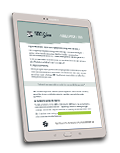Methane Spot Test – What Are We Really Measuring?
Recently, I have noticed the “methane spot test” advertised as a way to monitor treatment efficacy in high baseline methane positive SIBO patients. As this grows in popularity, I have some big concerns about this marker being overused and leading to the over-treatment of SIBO.
Claims are being made that the methane spot test can, detect the presence of methane in a constipated non-SIBO patient, and, it can help monitor the treatment efficacy in a high baseline methane-positive SIBO patient.
Let’s first look at the Lactulose Breath Test (LBT) as a whole and then we can discuss the methane spot test…
The LBT is used as a diagnostic tool to detect levels of excess hydrogen and methane that is produced when the consumed test substrate, lactulose, passes by higher than normal levels of organisms in the small intestine (bacteria and archaea are able to digest and ferment this sugar, but we cannot). The excess gas produced, exchanges across the intestinal tract, into the blood and then circulates and moves out through our lungs. Hydrogen and methane is measured as it is expelled out of our body through our breath.
This test is a validated laboratory test when, and only when, the subject has properly prepped for this test. This includes a 12 hour food prep, that occurs 24 hours prior to the test, of only fish, eggs, chicken, white rice and white bread (the latter two are allowed because they digest rapidly in the upper section of the small intestine). Then the subject fasts for 12 hours, and then waits two hours after getting out of bed in the morning (because morning breathing is more shallow breathing) to take a baseline measure.
The baseline measure is a control marker for the lab, to show that the test prep was done properly. This baseline measure is also what is being called a ‘methane spot test.’
After the baseline measure is taken, the subject consumes a standard dose of lactulose. Depending on the test, the subject is instructed to collect breath samples in 15 to 30 minute increments, for 90-180 minutes.
When collecting a breath sample, the subject is instructed not to gulp air; they are simply to breathe in and out normally. The CO2 measure on the report is to control for lung air (to confirm that the subject did not overly gulp outside air while performing the test).
The proper 12 hour food prep reduces fermentable foods and the fermentation potential of the organisms that reside in the large intestine. By reducing the load of fermentation in the large intestine, we are able to get a clearer measure of gases in the small intestine as the lactulose substrate moves past the organisms.
Bacteria will not spontaneously ferment in the digestive tract. They are fermenting what we feed them. If prepping incorrectly, this is simply a measure of the fermentation of food, fibers, and waste that is in the colon.
How did the ‘Methane Spot Test’ gain in popularity?
One study, the “Selection of a cut-off for high- and low-methane producers using a spot-methane breath test: results from a large north American data-set of hydrogen, methane and carbon dioxide measurements in breath,” by Gottlieb et al. compared 11,674 LBT samples submitted to Commonwealth Laboratories over a one year period. They compared baseline methane measures to the full test results and concluded that if the baseline measure of methane was 4 ppm, or more, this highly correlated to a positive methane result on the full LBT test. To note, methane is considered positive on the LBT if a reading of 10 ppm or more is present at any point in time during the test, from the second collection time and up to the 90 minute mark.
This sounds convincing, but here is the problem, Commonwealth Laboratories did not use Quintron machines for the LBT, which is the machine that was used to validate the LBT . They also used screw cap lids for their breath collection devices, which doesn’t allow for the concise collection of the breath samples, and there may be some leakage in transit.
"Methane Spot Test, What Are We Really Measuring, at SIBOGuru.com"
↑ Tweet ThisMany of us working knee deep in the SIBO world have seen an ungodly number of flat lined methane tests come from this laboratory. This is a topic that has been well debated among the SIBO clinicians, and the consensus among the majority of us is that this lab was not producing valid results. This lab has since reopened under the same ownership, under a new name, Commonwealth Diagnostics International. They have shortened their analysis for SIBO to 2 hours and 15 min, with 15 minute collection intervals. They are still using screw top test tubes. I do not recommend running SIBO testing through this lab. My favorite go-to lab for SIBO testing is Aerodiagnostics.
Clinical Implementation of the Methane Spot Test
Although the people performing the original LBT test, would have undergone a proper food prep and fasting period, this is not how the ‘methane spot test’ is being implemented.
When the ‘methane spot test’ is being utilized in a clinical setting, some patients are being asked to fast, but many are not. Most are not properly following the 12 hour food prep. The test is being used in a clinical setting, to measure a single point of methane anywhere along the day, without regard to food prep and fasting state. This is not how the LBT was validated for use, nor is the ‘methane spot test’ a validated laboratory test. We need more research on this.
The way that the LBT works is that it is measuring gas production when food is fermented by bacteria (the ‘food’ is the standardized 10 gram dose of lactulose). If food is in the colon, due to poor test prep, then this test is measuring colonic gas produced by organisms in the colon, consuming our diet, which will vary greatly over a period of time. Let’s say that the proper 12 hour food prep and 12 hour fast, and 2 hour window post rise timeline is in place – what then, is the ‘methane spot test’ measuring?
If we look at the claim, that it identifies methane in a non-SIBO patient – where is the validation of this lab? How do we know that a single vial baseline breath measure of methane, reflects colonic fermentation alone? Who among us hasn’t seen a baseline methane measure that is elevated, and then the next few markers are all low? If colonic methane production is elevated, why would we not see a continued elevation of methane levels throughout the test? Also, although methane production is linked with slowed motility, is not always correlated in each group studied.
In a 2018 study that looked at methane production in 23 IBS-C and 68 non-constipating IBS subjects, they found that 13 of the IBS-C were methane producers and 25 or the 68 non-constipating IBS patients were methane producers. And, of these subjects, only 8 of the 13 IBS-C methane producers had altered transit time (measured by abnormal CTT, marker retention). But, they also found that 5 of 10 non-methane producers had abnormal CTT, marker retention. https://www.ncbi.nlm.nih.gov/pubmed/30406392
If we are looking to the ‘methane spot test’ to track efficacy of treatment, or identify methane in an non-SIBO patient, we need to know the following information: what is the standard level of methane, data from control groups, acceptable ranges, treatment range, etc. Have we compared ‘methane spot testing’ at various points along the day? How replicable is this test?
Studies that have looked at breath methane and how this correlates with transit time and constipation, are measuring breath methane over hours, not at a single point in time (https://www.ncbi.nlm.nih.gov/pubmed/17397408
If eating the wrong foods during the 12 hour food prep, or eating up until bedtime, or eating during the test, then what are we really measuring? An individual’s response to eating? This is not a baseline measure of small or large intestine fermentation. If the wrong foods are consumed during the prep time, the test is no longer valid. It was not validated consuming any other foods. It was only validated using these exact foods and a standard dose of test substrate.
I feel that there is enough controversy around the LBT, let alone shortening this up to a single currently unvalidated marker.
Additionally, since the standard treatment of methane dominant SIBO in the allopathic world is Rifaximin and Neomycin or Metronidazole, we should tread lightly about over-diagnosing and over-treating and overusing antibiotics. Without further research, using a methane spot test to treat SIBO – track protocol efficacy, or identify methane in a non-SIBO patient, is premature, at best.
Enjoying this content? Sign up for updates... It's FREE!


















Comments
from 4 people
Hi Dee, I am not in any way criticizing the LBT. I am stating that the methane spot test is not a validated laboratory test. In doing so, I needed to explain how the LBT works and what the methane spot test is. The methane spot test, which is the same single marker collected as a baseline reading, that the laboratory uses as a control to ensure that the prep was done correctly, is not a validated laboratory test.
Angela Pifer
I'm sorry, but I don't get your point. I did the properly timed and performed LBT with proper prep and am 16 and 40 in the 2 gases tested for. Overseen by a really good gastroenterologist.....at least I think so. How am I supposed to view your cynicism about the LBT?
Dee
Sad!!! Thanks for the warming ... i have always used Aerodiagnostics for my SIBO test
SIBO Patient